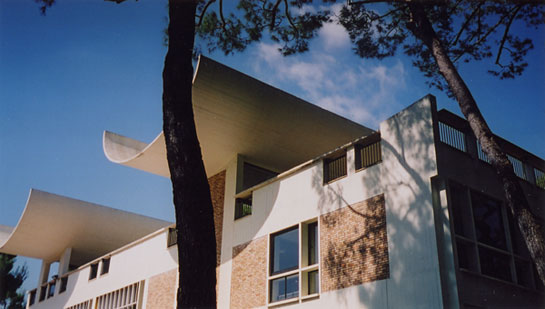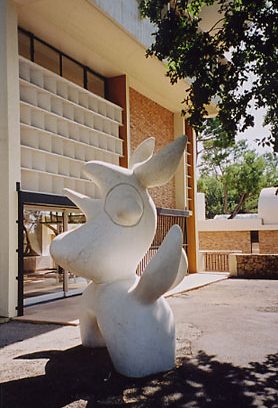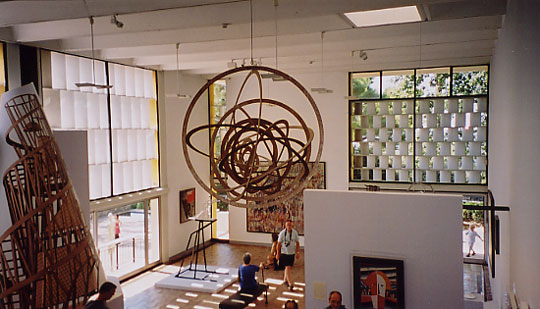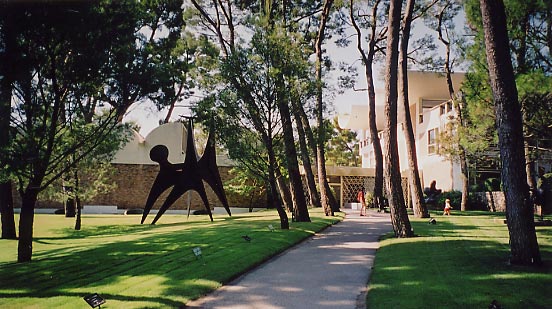This website uses cookies
This website uses cookies to enable it to function properly and to analyse how the website is used. Please click 'Close' to accept and continue using the website.






November 2003 - Maeght Foundation, St Paul de Vence, France
An olive stone’s throw away from the jet-set haunt of La Colombe d’Or restaurant on the tourist-infested Cote d’Azur, lies an oasis of cultural calmness. The Aimé and Marguerite Maeght Foundation constitutes one of the most important collections of twentieth century art in Europe. Conceived in the late 1950s, the idea of creating a contemporary art institution was fairly audacious, indeed unheard-of in Europe. Four decades after its completion, it continues to work well as a place to view, study and enjoy art in peaceful and meditative surroundings.
Originally from Cannes, Aimé Maeght was a renowned art dealer and publisher living in Paris. It was the cubist artist, Georges Braque who suggested that the couple built an artistic foundation. There were no precedents, no models, but in 1960, the Maeghts visited the artist, Joan Miro’s studio in Palma, Mallorca, and took an instant liking to the design, which was by Josep-Lluis Sert. They remembered the Spanish Pavilion for the Exposition Universelle in Paris in 1937, which Sert had also realised, and where Calder, Miro and Picasso had exhibited work, including ‘Guernica’. Two years before, the architect had succeeded Walter Gropius as Dean of the Harvard School of Design, where he was preaching a new unity of architecture and town planning. He immediately agreed to undertake the new project for the French philanthropists.
Sert was a Catalan who had helped found the Spanish branch of the Modern movement in the 1930s, GATEPAC (Grupo de Arquitectos para el Progreso de la Arquitectura Contemporeana). Sert had also worked with Le Corbusier in Paris, and he developed a ‘Unité d’habitation’ of his own, for university housing, at Harvard. In 1942, he published the book, ‘Can Our Cities Survive?’ in which he spread the CIAM (Congres Internationaux de l’Architecture Moderne) pre-war, urban doctrine in the English-speaking world.
Sert’s earlier Pavilion was meant to demonstrate the liberal egalitarianism of the Spanish Second Republic. As well as being a statement of International Modernism, there were distinctly Spanish elements, including a patio; the shading of slats and ventilating screens. Sert talked of a “meridional architecture” in which vernacular devices, such as loggias, terraces, awnings and screens, would be re-interpreted in modernist form.
In 1955, Sert returned to Spain from America, whence he had fled from the Franco regime, to design Miro’s atelier in Mallorca. The building had a series of inter-locking Catalan-influenced vaults, a whitewashed concrete outline with grilles to diffuse the sunlight, and textured rubble walls, ideas developed in the Maeght Foundation.
Aimé wanted a contemporary, functional and effective design for the appreciation of the collection, and as nature lovers, they also wanted the foundation to be integrated into a large, Mediterranean garden. Thus Sert had to adapt a functional building to its natural landscape, “installing a museum inside Nature” as he put it. His overall design was a series of inter-connected, one- to three- storey buildings that respected the slope of the land and which were set comfortably amongst the pine trees. The different roof shapes, levels of rooms and terraces, and the combination of materials (concrete and pink hand-thrown bricks) give variety for the eye.
Sert tamed and harnessed the Mediterranean light with quadrantal cylinder windows. Their parabolic curve traps and transmits the even and constant light directly on to the exhibition walls at the height of the paintings. Moreover, he discussed the precise lighting requirements with Braque, Chagall and Miro, in order to display their pictures to the greatest advantage. The Maeghts, although not super rich, allowed Sert to build full-size models that were moved around the site for a year to test the best orientation. In addition, several walls open to the outdoors, overlooking the sculpture gardens, terraces, lush lawns, light blue and green-tiled pools and woods. And in the double-height exhibition space, two large window-screens, with built-in shutters, serve to break up and diffuse the sunlight.
In contrast to the light traps and expressed vaults, the largest building is capped with two, large, u-shaped, twentieth century impluvia that also act to visually lighten the whole exterior. These white, concrete basins collect valuable rainwater, which is distributed to the pools and fountains and is also used to humidify the interior air. Their silhouette, which bears some resemblance to one of Miro’s favourite shapes, is used as the logo for the Foundation.
Artists worked in close collaboration with the architect by creating an accumulation of large works that naturally integrate with the edifice and the environment. The oeuvre is of such richness that it includes the Giacometti courtyard with tall, emblematic figures; Miro’s ceramic and sculptural labyrinth; wall mosaics by Chagall; Pol Bury’s steel-tubes fountain; a Braque mosaic on the bottom of a pool; Alexander Calder industrial-size sculptures and mobiles, in the chapel, stained-glass windows by Braque and, in the cafeteria, furniture designed by Giacometti.
Monsieur Maeght had intended the complex to include several outbuildings, which would house visiting artists from around the world, who wanted to stay temporarily at the Foundation. Only one of these annexes was realised and this has been converted into the institution’s library.
Amid the tourists of the Cote d’Azur lies this twentieth century architectural monument whose architect once referred to “human landmarks…intended to outlive the period which originated them” and as the “expression of man’s highest cultural needs”. There is hope yet.
The Maeght Foundation can be visited from 1st October – 30 June 10:00 – 12:30 & 14:30 – 18:00; 1st July – 30 September 10:00 – 19:00 without interruption. Entrance €10 adults, €8 children, free for children under 10.
Maeght Foundation, 06570 Saint-Paul, France. Tel: + 33 (0)4 93 32 81 63, Fax: + 33 (0)4 93 32 53 22, Email : contact(at)fondation-maeght.com, Website : www.fondation-maeght.com
Look for past Buildings of the Month by entering the name of an individual building or architect or browsing the drop down list.

Become a C20 member today and help save our modern design heritage.